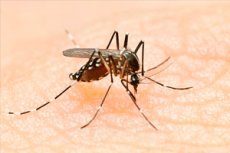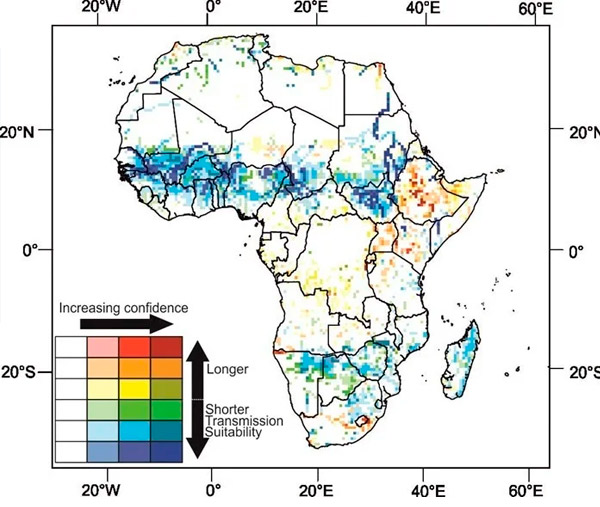Nye publikasjoner
Ny modell forutser klimaendringenes innvirkning på malariasmitte i Afrika
Sist anmeldt: 02.07.2025

Alt iLive-innhold blir gjennomgått med medisin eller faktisk kontrollert for å sikre så mye faktuell nøyaktighet som mulig.
Vi har strenge retningslinjer for innkjøp og kun kobling til anerkjente medieområder, akademiske forskningsinstitusjoner og, når det er mulig, medisinsk peer-evaluerte studier. Merk at tallene i parenteser ([1], [2], etc.) er klikkbare koblinger til disse studiene.
Hvis du føler at noe av innholdet vårt er unøyaktig, utdatert eller ellers tvilsomt, velg det og trykk Ctrl + Enter.

En ny modell for å forutsi virkningen av klimaendringer på malariasmitte i Afrika kan føre til mer målrettede tiltak for å kontrollere sykdommen, ifølge en ny studie.
Tidligere metoder brukte total nedbør for å indikere tilstedeværelsen av overflatevann som er egnet for myggoppdrett, men studien, ledet av University of Leeds, brukte flere klima- og hydrologiske modeller for å redegjøre for de virkelige prosessene med fordampning, infiltrasjon og strømning gjennom elver.
Denne banebrytende tilnærmingen har skapt en dypere forståelse av forholdene som er gunstige for malaria på det afrikanske kontinentet.

Prognerte endringer i lengden på sesongen som er egnet for malariaoverføring innen 2100 under et scenario med høye utslipp. Røde nyanser indikerer økende sesonglengde, mens blå nyanser indikerer avtagende sesonglengde. Intensiteten i fargen indikerer tillit til estimatene. Bildekreditt: University of Leeds.
Den fremhevet også rollen til vassdrag som Zambezi-elven i spredningen av sykdommen, med nesten fire ganger flere mennesker anslått å bo i malariavennlige områder i opptil ni måneder i året enn tidligere antatt.
Studien, med tittelen «Fremtidig miljømessig egnethet for malaria i Afrika er følsom for hydrologi», ble finansiert av National Natural Resources Council og publisert 9. mai 2024 i tidsskriftet Science.
Dr. Mark Smith, førsteamanuensis i vannvitenskap ved University of Leeds' geografiske institutt og hovedforfatter av studien, sa: «Dette vil gi oss en mer realistisk vurdering av hvor i Afrika ting vil bli bedre eller verre for malaria.»
«Og etter hvert som mer detaljerte estimater av vannføring blir tilgjengelige, kan vi bruke denne forståelsen til å veilede prioriteringer og skreddersy malariaintervensjoner på en mer målrettet og informert måte. Dette er veldig nyttig gitt de ofte begrensede helseressursene.»
Malaria er en klimasensitiv vektorsykdom som forårsaket 608 000 dødsfall blant 249 millioner tilfeller i 2022.
Nittifem prosent av de globale tilfellene rapporteres i Afrika, men nedgangen i tilfeller der har avtatt eller til og med snudd de siste årene, delvis på grunn av stillestående investeringer i den globale responsen på malariakontroll.
Forskere spår at varme og tørre forhold forårsaket av klimaendringer vil føre til en generell reduksjon i områder som er egnet for malariaoverføring fra 2025.
Den nye hydrologibaserte tilnærmingen viser også at endringer i malariaens egnethet forekommer på tvers av steder og er mer følsomme for fremtidige klimagassutslipp enn tidligere antatt.
For eksempel er den anslåtte nedgangen i malariaegnethet i Vest-Afrika mer omfattende enn nedbørsbaserte modeller antydet, og strekker seg så langt øst som Sør-Sudan, mens den anslåtte økningen i det sørlige Afrika nå antas å følge vassdrag som Orange-elven.
Medforfatter av studien, professor Chris Thomas fra University of Lincoln, sa: «Et viktig fremskritt er at disse modellene tar hensyn til at ikke alt vann blir værende der det regner, noe som betyr at yngleforhold som er egnet for malariamygg også kan være mer utbredt – spesielt langs store elveflomsletter i de tørre savanneområdene som kjennetegner mange deler av Afrika.»
«Det som er overraskende med den nye modelleringen er hvor følsom sesongens lengde er for klimaendringer – dette kan ha dramatiske implikasjoner for mengden sykdom som overføres», sa Simon Gosling, professor i klimarisiko og miljømodellering ved University of Nottingham, som var medforfatter av studien og bidro til å koordinere vannmodelleringseksperimentene som ble brukt i forskningen.
Studien vår fremhever den komplekse måten endringer i overflatevannsstrømmer endrer risikoen for malariasmitte i Afrika, muliggjort av et stort vitenskapelig program gjennomført av det globale hydrologiske modelleringsmiljøet for å samle og gi vurderinger av klimaendringers virkninger på vannstrømmer over hele planeten.
Selv om den generelle reduksjonen i fremtidig malariarisiko kan høres ut som gode nyheter, kommer den på bekostning av redusert vanntilgang og en større risiko for en annen betydelig sykdom, dengue.
